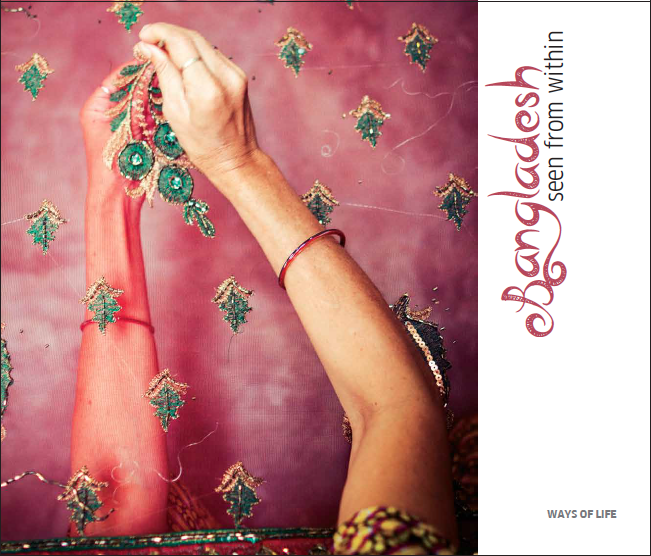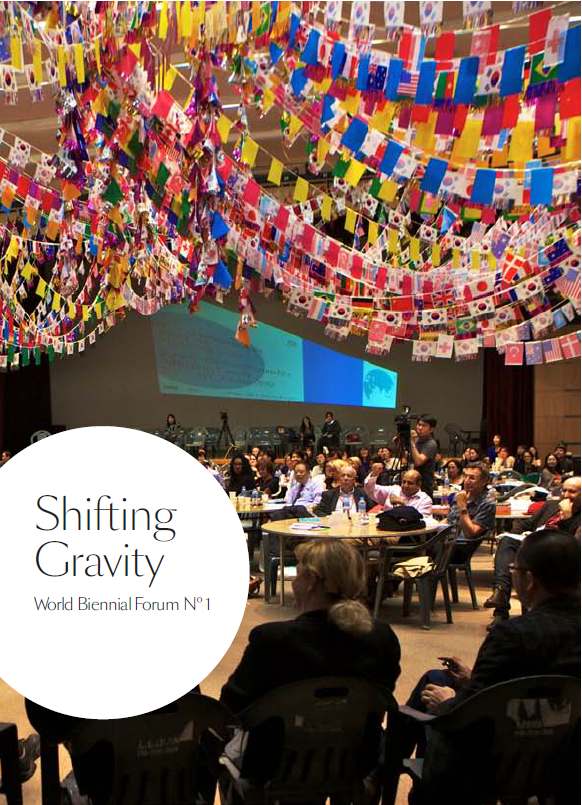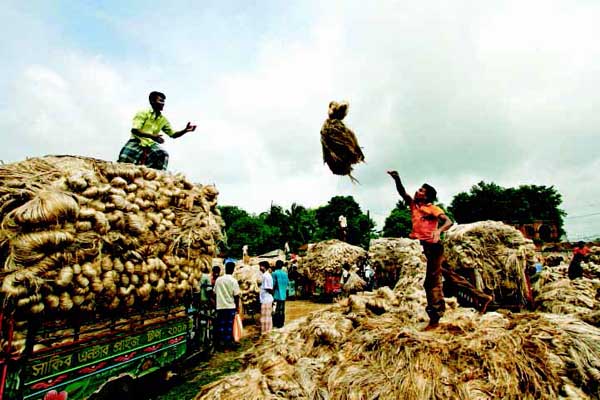
Design: Mahbub/Drik
We spot a lens peering at us from the corner of our eye. Immediately we straighten up, fix our hair, smooth the rough in our clothes, consciously make – or avoid – eye contact. Only the well trained is able to visibly avoid responding to the camera?s presence. The professional photographer prides in her ability to take ?natural? photographs, where her intervention is invisible. Yet, peering through family albums, wedding folders or a Facebook status we find ourselves actively inviting the portrayal of how we want to be seen. Whether we consider a photograph of ourselves to be ?good? largely depends on how well the photographer has represented us, as we would want it. As such the photographer?s success depends not so much on her aesthetic sense or insight, but on her ability to please the sitter. While this applies to the casual portraitist, it is much more true of the professional photographer. Her bread and butter depend on a satisfied client and as such, are driven by an external agenda. Whether it be a corporation, or an NGO or a newly wed couple, a good photographer is one who delivers what is required. Continue reading “Embracing the Amateur”
Tag: publication
Launch of Shifting Gravity in Venice
Book Launch: Shifting Gravity A Discourse on Biennials
May 30, 2013, 6:00pm-8:00pm
Hotel Monaco & Grand Canal,
Crozzola Hall, Venice, Italy

The Gwangju Biennale Foundation is pleased to invite you to the launch of the book?Shifting Gravity on the 30th of May at Hotel Monaco & Grand Canal in Venice, Italy. This?book, published by the Gwangju Biennale Foundation and Hatje Cantz, presents the issues,?discourses, and practices that have been evolving over the past 20 years with the?development of biennials around the globe.
The catalyst for this publication was the World Biennial Forum No.1, an international forum?held in Gwangju, South Korea in October 2012. The forum and publication were organized?through the collaboration of the Gwangju Biennale Foundation, the Biennial Foundation,?and the ifa (Institut f?r Auslandsbeziehungen). During the five-day forum, directors and?representatives of biennials and a number of professionals discussed a wide range of?issues regarding biennials and their meaning as a global cultural phenomenon.
Shifting Gravity is composed of three main essays on the theme of biennials and thirty-nine?essays on different biennials held around the globe. Ute Meta Bauer and Hou Hanru, the?directors of the forum, took on the role of editors for the publication of the book.
Chobi Mela is one of the biennales featured.
For RSVP please contact:?Serene Pac
Ten Photos, Ten Stories: Munem Wasif on GMB Akash
by Naeem Mohaiemen

Ten Photographs, Ten Stories[Translated from Bengali by Naeem Mohaiemen]
By then, the inevitable happened. First Shahidul, then Shehzad, Abir, Kiron? one after another, a daring piece of work. All hard core black-and-white, capturing a humane moment. Akash also started out in this mode. There was a unique caring in his photographs. A forgetful rider on an exhausted horse at the beach. Or, an intimate scene of Akash’s mother bathing his grandfather. These early black and white photographs carry the shadows of that established style. In any case, there was tremendous pressure on the younger photographers. Difficult to stand with your head held high. Not easy to brush off the weight of that established structure. If there is no new language, new stories cannot be told. Then even breathing became difficult. Continue reading “Ten Photos, Ten Stories: Munem Wasif on GMB Akash”
The Best Photo Books of 2011
Subscribe to ShahidulNews
- By Jack Crager and Lindsay Comstock on December 1, 2011
Our 50 Favorite Books of 2011
Documentary & Photojournalism
Views of a changing world from its most curious and insistent witnesses
Tibet: Culture on the Edge,?Phil Borges
Rizzoli
In his fifth monograph, Borges explores both the indigenous lifestyles of the Tibetan people and their grand surroundings?each threatened by forces including industrial development, climate change and ongoing political tension between Tibet and the People?s Republic of China. Forged over 17 years of periodic visits, Borges?s affinity with the hardy natives informs the book?s illuminating text and warm portraits alike.?$45
Is This Place Great or What, by Brian Ulrich
Aperture
(See our interview with Brian and additional samples from?Is This Place Great or What here).?In a decade-long survey of American consumerism, Ulrich casts a wry eye on the nation?s shoppers and employees in big-box outlets and thrift shops?contrasting boom-years decadence and bust-years desolation with chilling irony.?$50
My Journey as a Witness, by Shahidul Alam
Rizzoli
Seeking to preserve justice and human rights through the power of the lens, Alam depicts cultures of Bangladesh, China and Pakistan in compassionate black-and-white images punctuated by saturated color bursts.?$50
Questions Without Answers: The World in Pictures, by the Photographers of VII,
Phaidon
Since its founding in 2001, independent photo agency VII has been responsible for some of the decade?s most significant documentary photography, as evidenced by this hefty collection of images from Alexandra Boulet, Ron Haviv, John Stanmeyer, Christopher Morris and others.$75
Memory Remains: 9/11 Artifacts at Hangar 17, by Francesc Torres
National Geographic
The human impact of 9/11 is painted in relief through these poignant images of objects removed from New York City?s Ground Zero and stored at JFK airport, waiting to to be documented by the National September 11 Memorial and Museum.?$50
The New York Times Magazine Photographs,?edited by Kathy Ryan
Aperture
Covering three decades, this volume showcases The New York Times Magazine?s reliable blend of ambitious photojournalism and inventive illustrative work.?$75

Afterwards, edited by Nathalie Herschdorfer,
Thames & Hudson
Photographers are naturally drawn to shooting disasters, not so much to what happens next. This aching collection spanning
60 years shows what happens when they stick around.?$50
Inauguration,?by Catherine Opie
Gregory R. Miller
Opie commemorates the inauguration of the first black U.S. president, Barack Obama, in shots of personal candor and celebratory energy.?$50
Hard Ground,?by Michael O’Brien,
University of Texas Press
O?Brien turns his lens on the homeless, lending them a quiet dignity in portraits made all the more moving by poetry from singer-songwriter Tom Waits.?$40
Permanent Error,?by Peter Hugo
Prestel
Documentarian Hugo delivers a gripping account from Ghana: At the Agbogbloshie dump outside Accra, men and children filter through electronic waste for scraps and metal that can be melted down and sold for tiny profits. The haunting scenes from these breathtakingly toxic waste grounds powerfully signal the hazards of electronic consumption and planned obsolescence.?$50
A Window on Africa: Ethiopian Portraits,?by Hans Silvester,
Thames & Hudson
Silvester?s portraits of natives reveal their steely characters and changing lifestyles in the face of modernity.?$40
BANGLADESH PHOTOBOOK READER PRIZE
Subscribe to ShahidulNews
Shahidul Alam?s ?My Journey as a Witness?: book excerpt and giveaway
Head on down past the fascinating opening essay from the book excerpted below, put together by curator and writer Rosa Maria Falvo, to find out how to win!
 Shahidul Alam, ‘Ilish fishing’. Image from book. ? Shahidul Alam.
Shahidul Alam, ‘Ilish fishing’. Image from book. ? Shahidul Alam.
Impossible is nothing
Few Westerners have any understanding of Bangladesh?s complicated history or even know exactly where it is on a map. And fewer still have experienced what this country has to offer. I first went there in 2008, travelling to Dhaka from Kolkata by bus across the Indian-Bangladeshi border at Benapole, and after our first ?luxury? bus ripped a hole in its undercarriage as the driver forced the ferry ramp prematurely, we jumped onto another making its way into the belly of a night ferry, crossing the Padma (?lotus?) River, the main channel of the great Ganges (Ganga) River originating in the Himalayas. Immediately surrounded by a smiling and curious crowd, it felt exhilarating to be suddenly thrust into the enduring dynamism that is daily life in Bangladesh. Washing over my vague but cemented notions of disaster and poverty, the reality for me was inspiring, within the chaos and calm combined. I have since travelled southwards to Chittagong?s great seaport, and then north into Bogra, through Dinajpur, visiting temples and monasteries, onto Rangpur, stopping for tea with indigo farmers, heading west to Thakurgaon, giving way to elephants on the village roads, and across India on our way to Biratnagar, Nepal. Increasingly, I am struck by the pervading ?impossible is nothing? approach to life here, and by the magnanimity of the people of Bangladesh.
We met a cheeky bearded man on a bicycle, busily navigating his schedule in a city that relentlessly thwarts any plans one might have to move promptly from A to B. To describe Dhaka?s serious traffic problems is to begin with sheer understatement, and yet the locals carry on undeterred. We walked into his photo agency full of energetic youth, with an obvious respect for their teacher, in positions of responsibility that showed they belong.
Working alongside Shahidul Alam is an extraordinary experience. There is no self-righteous arrogance, impatient hustling, or delusions of grandeur. Here is a true humanitarian; honest, hard-working, and committed to the cause; a talented man who is loved by many in a social, political and environmental system that is bursting at the seams; one that needs overhauling; and one he has been intimately engaged with for over thirty years. In the most unlikely conditions, with the odds (and sometimes the guns) pointed squarely against him, he manages to get the job done with a centeredness that inspires others to do the same. And what exactly is that job? Born from a simple premise and pitted against a seemingly impossible challenge, he dares to turn perceptions around and broaden our thinking, to rebalance the dynamics of communicative power, to redistribute imagery that impacts contemporary culture, and to respect geographic diversification. Not one to shy from the harshest realities in his country, which are best understood by those living them, Alam is educating for a new vision, which enlightened photography aspires to convey. If we consider the classic vehicles of social control, what happens when multinationals and politicians representing eight countries monopolise a world whose ?majority? often stands like an elephant tied to a rope? This majority will inevitably find its strength and something practical and peaceful can be done to help recognise it.
People's News
Subscribe to ShahidulNews
Drik calendar 2012 now available:

A moment of crisis, a celebration, the unexpected, a dream realized, hidden truths, a reaffirmation of what we knew. Through TV screens, newspaper pages, giant electronic screens and tiny handsets, we gather, sift, scroll and parse news unfolding. Through twitter feeds, facebook and blogs, we circulate the news that we are fed, to inform, alert and mobilise those around us. Occasionally we question. The news photograph brings down powerful autocrats, highlights the plight of a single child, shines a spotlight on communities in strife, ignites the passion of victory, shares the tragedy of loss.

But the manufacture of consent has rarely been more engineered. With everything from wars to presidential campaigns being stage-managed and with mainstream news increasingly fed by official sources, reliance on usual sources of news images has become increasingly dangerous. Continue reading “People's News”
My journey as a witness on National Geographic website
Subscribe to ShahidulNews
About the book
This book showcases Shahidul Alam?s photographs, more than 100 color and black and white plates illustrating the journey of an artistic, social, and political witness from inside Bangladesh. This groundbreaking work retraces his personal vision spanning three decades and provides the best interpretative and investigative angles into a culture and reality that is otherwise often misunderstood in the West. Using photography and journalism as its parameters, it is the first comprehensive vision of Bangladesh. These images are not ?about? the region from a European perspective, nor are they an ethnographic account of an ex-colonial world. Instead, this volume is an ?on-the-ground? insight, exploring its topography with decidedly competent indigenous eyes. A personal ?way of seeing? ? the journey of a witness ? this book offers a reflective picturing of national and geographical truths, where the ?other? is no longer a stranger. Alam provides a purposeful alternative to the media driven images of poverty and destruction, literally defying received notions of the Subcontinent. After many years of struggle, he is a pioneering catalyst, inspiring development from within his ?majority world?; founding an artistic movement that cannot be silenced: the emergence of local photographers, achieving an intimacy with their subjects that truly understands and so rivals Western perceptions.
Alam?s image making carries its editorial eloquence far beyond its subject matter. For over 30 years, he has led the way in developing photography as a discipline in Bangladesh, producing an entirely new generation of acclaimed artists in the international arena. His writing style is personal, sometimes fast paced, often reflective, with magnificent imagery interwoven throughout the narrative.
Purchase?My Journey as a Witness here
About the author
Shahidul Alam is a photographer, writer, curator and activist. He obtained a PhD in chemistry at London University before switching to photography. He returned to his hometown Dhaka in 1984, where he photographed the democratic struggle to remove General Ershad. A former president of the Bangladesh Photographic Society, Alam set up the award winning Drik Agency, the Bangladesh Photographic Institute, and Pathshala, the South Asian Institute of Photography; considered one of the finest schools of photography in the world. Director of the Chobi Mela International Photo Festival and chairman of Majority World Agency, Alam?s work has been exhibited in galleries such as?MOMA in New York, the Centre Georges Pompidou in Paris, the Royal Albert Hall in London and The Museum of Contemporary Arts in Tehran. A guest curator of the National Art Gallery in Malaysia and the Brussels Biennale, Alam?s numerous photographic awards include the Mother Jones and the Andrea Frank Awards. He has been a jury member in prestigious international contests, including World Press Photo, which he chaired. An Honourary Fellow of the Bangladesh Photographic Society and the Royal Photographic Society, Alam is a visiting professor of Sunderland University in the UK and principal of the South Asian Media Academy in Dhaka, Bangladesh. A prominent social activist Shahidul Alam is also a promoter of new media and has lectured and published widely on photography, new media and education, in the?USA, Europe, Africa, Asia, Australia and Latin America.
London launch: My journey as a witness
Subscribe to ShahidulNews

Book Launch: Organised by Candlestar

An extraordinary artist, Shahidul Alam is a photographer, writer, activist, and social entrepreneur who uses his art to chronicle the social and artistic struggles.
Lucid and personal, this much-awaited book includes over 100 photographs tracing Alam?s artistic career, activism, and the founding of photography organisations. From early images shot in England to photographs of the last two decades in his native Bangladesh, this is a journey from photojournalism into social justice. Alam?s superb imagery is matched by his perceptive accounts that are at once deeply intimate and bitingly satirical.
Supported by the Bengal Foundation and published by Skira Editore there will be a short film and brief talks by the author, editor and sponsor accompanied by a book signing.
Date and Venue:
5.30 – 7.30pm Monday 10th October 2011
Hyatt Regency London – The Churchill
Library Room
30 Portman Square,
London, W1H 7BH
Due to limited numbers please RSVP by Thursday 6th October RSVP to?info@candlestar.co.uk



